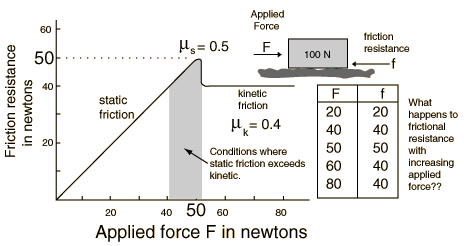Friction
Objective: To investigate the difference between static and kinetic friction.

1. Place the block on the incline and slowly tilt the incline until the block starts to slide from rest. Then obtain the coefficient of static friction as illustrated.

| Apparatus Movie |
Placing the block at the same point on the incline, repeat the procedure to get three values for ms and then average the values.

2. With repeated trials, elevate the incline from the horizontal and give the block a slight push to get it into motion. Find the angle at which the block neither speeds up or slows down, but moves down the incline at a constant velocity. (You are using your eye for judgement, and nonuniformity of the surface will affect this judgement, so the value obtained is not very accurate.) Find the coefficient of friction as above. This time it is the coefficient of moving or 'kinetic' friction.

3. Placing the incline horizontally on the table, attach a string and weight hanger as indicated. Using about the same point on the board as in part 1, find out how much mass must be added to start the block in motion from rest. Then find the mass of the block and the coefficient of static friction.

(Note that ms is a ratio of forces which are determined by the weights of the blocks, but since the masses are also proportional to the weights, the coefficient of friction

4. Using the same setup, give the block a slight push on each trial and find out how much hanging mass is required to maintain the block in motion at a constant velocity.
| mass added ________________________ |
| coefficient |  | = ____________________ |
5. Hold a meter stick horizontal, supported by one finger under each end. Move your fingers slowly toward each other. Describe the motion of the meter stick -- does it slide smoothly over both fingers? Explain why it moves as it does.
Equipment: Friction
| incline | block | vertical table rod |
| large 90° clamp | meter stick | small rod for incline support |
| mass hanger | scale | set of assorted masses |
Apparatus movie